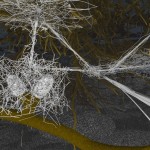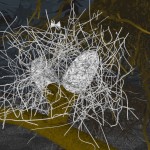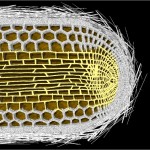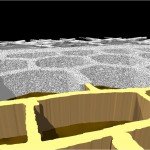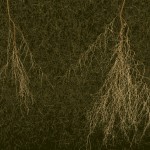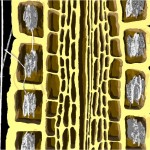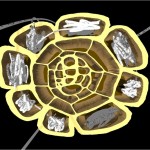Ectomycorrhiza and ericoid mycorrhiza are further forms of interactions of plant roots and fungi, which have evolved independently and at a later time points compared to arbuscular mycorrhiza. There are still more types of such interactions, but these three forms are the most important ones. While in most cases mycorrhizas are mutualistic interactions (i.e. beneficial for both partners), there are exceptions from this rule, most notably in orchid mycorrhiza (a fourth prominent type), which is not covered here.
Arbuscular mycorrhiza, the ancient standard type, is adapted to conditions of phosphorus limitations, which apparently prevailed, when the main land was first colonized by plants. Under conditions, however, when the recycling of dead plant tissue is restricted, nitrogen became limiting for plant growth. Ectomycorrhiza and ericoid mycorrhiza have evolved under such conditions and are particularly suited to them.
Ectomycorrhiza regards the roots of woody plants and primarily occurs in forests of the boreal and temperate climate zone. Different from arbuscular mycorrhiza, the fungi form robust hyphal structures, which are easily seen by the naked eye (hyphae are shown in white colour in the image below). These are in particular: hyphal mats colonizing the organic substrate in the soil extracting nutrients (most notably nitrogen), massive hyphal bundles (called rhizomorphs) transporting nutrients and symbiotic structures at colonized root tips, where nutrients are exchanged. (Again, as in all mutualistic forms of mycorrhiza, fungal mineral nutrients are exchanged versus plant carbohydrates). In addition, there are occasional macroscopic, fruiting bodies, which make a number of ectomycorrhizal fungi quite popular (Tuber melanosporum, Boletus edulis)
- Ectomycorrhizal diorama
As shown in the two images below, ectomycorrhizal symbiotic structures are very different from the basic, arbuscular mycorrhizal form. The fungi are covering the outer surface of colonized root tips with a dense hyphal coat. In addition, the cell walls of the outer cellular layers are colonized by massively folded fungal hyphae, this way forming a large plant-fungal interface necessary for the exchange of nutrients.
- Ectomycorrhiza: colonized root tips
- Ectomycorrhiza: sectioned root tip
Ericoid mycorrhiza is found in many members of the plant order Ericales (comprising plants like heather, cranberries, rhododendron). Such plants have adapted to conditions of extreme nitrogen deficiency, as, e.g., in raised bogs, and the formation of ericoid mycorrhiza is one strategy to cope with this deficiency. One additional characteristic feature of these plants is the formation of very dense, delicate root systems (growing below in a turf substrate).
- Ericoid root systems
Similar to the roots, the fungal structures in ericoid mycorrhiza are very delicate, comparably to arbuscular mycorrhiza. As in this latter interaction, individual cells from the root cortex are colonized. Different from arbuscular mycorrhiza, however, in ericoid mycorrhiza the outer cell layer of the (very shallow) cortex is targeted, not the internal layers. As a further difference from arbuscular mycorrhiza, coiled hyphal structures are formed in the colonized cells, not tree-like structures.
- Sectioned ericoid root
Further reading:

